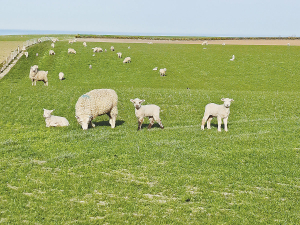University of Waikato research reveals 2050 drought threats
New research could help farmers prepare for a future where summer rainfall is increasingly unpredictable and where drought risk is rising, no matter what.
 Expected dry weather along the east coast of both islands builds a strong case for weaning at least a proportion of the lamb crop early.
Expected dry weather along the east coast of both islands builds a strong case for weaning at least a proportion of the lamb crop early.
A predicted dry summer, thanks to El Nino weather patterns, may make weaning a proportion of the lamb crop a good option this season.
The prospect of hot, dry weather along the east coast of both islands builds a strong case for weaning at least a proportion of the lamb crop early. This will allow high-quality feed to be partitioned into lambs while ewes recover body condition. It also provides the opportunity to sell cull ewes early.
Trials run at Massey University found lambs over 20kg LW coped best with early weaning (minimum weaning weight was 16kg LW). However, it was the quality of the forages on offer that was the greatest determinant of how well lambs grew post-weaning.
Professor Paul Kenyon, who led the early-weaning trials, says early weaned lambs should be given unrestricted access to legumebased forages such as a herb clover mix at a minimum cover of seven centimetres in height.
If lambs are weaned onto the crop, they should be given time to adjust to a change in feed. Running the ewe and lambs onto the crop a few days before weaning, then running the lambs back onto the crop after weaning will help minimise the weaning check.
He says in late lactation all lambs, but especially multiples, are receiving very little nutrition from the ewe, so when grass-growth is limited the ewes are competing with their lambs for feed, compromising the performance of both.
Early weaning can also be particularly useful in hoggets as it will give them more time to recover body condition between lambing and mating again as a two-tooth.
Partitioning high quality feed into lambs in the late spring early summer period will benefit the whole farm system. It means more lambs can be sold prime before the height of summermaking more feed available for capital stock – and ewe lambs can be grown out to heavier weights early. This means there is flexibility to hold them back later when feed resources are more limited.
BNZ says it is backing aspiring dairy farmers through an innovative new initiative that helps make the first step to farm ownership or sharemilking a little easier.
LIC chief executive David Chin says meeting the revised methane reduction targets will rely on practical science, smart technology, and genuine collaboration across the sector.
Lincoln University Dairy Farm will be tweaking some management practices after an animal welfare complaint laid in mid-August, despite the Ministry for Primary Industries (MPI) investigation into the complaint finding no cause for action.
A large slice of the $3.2 billion proposed capital return for Fonterra farmer shareholders could end up with the banks.
Opening a new $3 million methane research barn in Waikato this month, Agriculture Minister Todd McClay called on the dairy sector to “go as fast as you can and prove the concepts”.
New Zealand’s trade with the European Union has jumped $2 billion since a free trade deal entered into force in May last year.